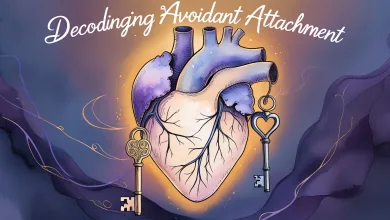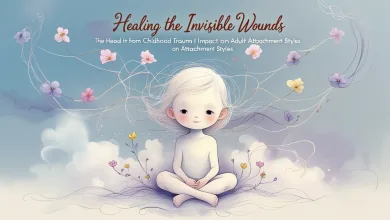15 Signs of Anxious Attachment Style: A Complete Guide (2025)

Did you know that approximately 20% of people exhibit an anxious attachment style? As someone who’s worked extensively with relationship dynamics, I’ve seen how this attachment pattern can significantly impact our closest relationships. Whether you’re navigating dating, marriage, or even friendships, understanding the signs of anxious attachment is the first step toward building healthier connections. But here’s the thing – recognizing these patterns in yourself isn’t always easy! Let’s explore the telltale signs and, more importantly, what you can do about them.
What Is Anxious Attachment Style?
Attachment theory, first developed by psychiatrist John Bowlby in the 1950s, provides a fundamental framework for understanding how our early childhood experiences shape our relationship patterns throughout life. An anxious attachment style, also known as preoccupied attachment, emerges when early caregiving experiences are inconsistent, leading to a deep-seated uncertainty about relationships and emotional connections.
The roots of anxious attachment can often be traced back to early childhood experiences where caregivers were unpredictable in their responses. Perhaps they were emotionally available one day but distant the next, or they may have alternated between being overly involved and surprisingly absent. As children, these individuals learned that love and support were available but not consistently reliable, leading them to develop hypervigilant strategies to maintain connection.
Through extensive research in attachment psychology, we now understand that approximately 20% of adults exhibit anxious attachment patterns. These patterns develop as adaptive responses to early environments where emotional needs were met sporadically. Children in these situations often become highly attuned to subtle changes in their caregivers’ moods and behaviors, developing what researchers call “protest behaviors” – actions designed to maintain proximity and attention from important attachment figures.
When comparing anxious attachment to other attachment styles, distinct patterns emerge. While securely attached individuals feel comfortable with both intimacy and independence, and avoidantly attached people tend to distance themselves emotionally, anxiously attached individuals often find themselves caught in a push-pull dynamic. Unlike the relative stability of secure attachment or the consistent emotional distance of avoidant attachment, anxious attachment creates a hyperawareness of relationship dynamics that can be emotionally exhausting.
Disorganized attachment, which develops from more severe early trauma, shares some characteristics with anxious attachment but typically involves more extreme and contradictory behaviors. While anxiously attached individuals generally move toward relationships despite their fears, those with disorganized attachment often simultaneously seek and reject connection in more chaotic patterns.
The impact of anxious attachment extends far beyond childhood, significantly influencing adult relationships and emotional well-being. In romantic partnerships, anxiously attached individuals often struggle with intense fears of abandonment, leading to behaviors like excessive reassurance-seeking, difficulty with personal boundaries, and heightened emotional responses to perceived rejection. These patterns can create self-fulfilling prophecies, where the fear of losing a partner actually strains the relationship.
Research in neuroscience has shown that anxious attachment can affect the brain’s stress response system, leading to heightened cortisol levels during relationship conflicts and difficulty regulating emotions. This biological component explains why anxiously attached individuals often experience physical symptoms like stomach issues, sleep problems, or anxiety during relationship stress.
Understanding anxious attachment as a learned adaptation rather than a personal flaw is crucial for healing. These patterns developed as survival strategies in early life, and while they may no longer serve their original purpose, they represent the mind’s attempt to maintain emotional safety. With this compassionate perspective, individuals can begin to recognize their attachment patterns as starting points for growth rather than permanent limitations.
Physical and Emotional Signs of Anxious Attachment
Living with an anxious attachment style creates a unique interplay between mind and body, manifesting in both physical sensations and emotional experiences. Recent research in psychosomatic medicine has revealed that attachment patterns significantly influence our nervous system’s response to relationship stress, creating a distinct pattern of physical and emotional symptoms that can feel overwhelming and confusing.
The body’s response to attachment anxiety often manifests through heightened nervous system activation. When relationship triggers occur – whether it’s an unanswered text message or perceived emotional distance from a partner – the sympathetic nervous system kicks into high gear. This activation can lead to a racing heart, with studies showing elevated heart rate variability in individuals with anxious attachment during relationship-related stress. Many people report experiencing persistent stomach problems, including digestive issues and a “knot in the stomach” sensation, particularly during periods of relationship uncertainty. Sleep disturbances are equally common, with difficulties falling asleep or maintaining restful sleep due to racing thoughts about relationships.
Emotional dysregulation stands as a hallmark sign of anxious attachment. Unlike individuals with secure attachment who can generally maintain emotional equilibrium during relationship stress, those with anxious attachment often experience emotions with heightened intensity. This manifests as rapid mood swings, from extreme happiness when receiving validation to deep despair when facing perceived rejection. The emotional experience can feel like being on an endless roller coaster, with feelings shifting dramatically based on relationship cues or partner responses.
One of the most challenging aspects of anxious attachment is the profound difficulty with uncertainty and unknown situations. The attachment system becomes activated when faced with ambiguity in relationships, leading to what researchers call “intolerance of uncertainty.” This manifests as excessive worry about future scenarios, constant need for clarity about relationship status, and difficulty trusting positive experiences without questioning their permanence. Studies have shown that this intolerance of uncertainty often correlates with higher levels of relationship anxiety and decreased relationship satisfaction.
Physical symptoms during relationship stress or conflict can be particularly intense for those with anxious attachment. During arguments or periods of disconnection, individuals might experience muscle tension, headaches, fatigue, or even chest tightness. These physical manifestations often create a feedback loop – the body’s stress response triggers more anxiety, which in turn intensifies physical symptoms. Research has demonstrated that this mind-body connection is particularly strong in anxiously attached individuals, with their bodies showing stronger physiological reactions to relationship threats compared to those with other attachment styles.
Understanding these physical and emotional signs serves multiple purposes. First, it validates the very real physical and emotional experiences that anxiously attached individuals face. Second, it provides a framework for recognizing when attachment anxiety is being triggered, allowing for earlier intervention with coping strategies. Finally, it highlights the importance of addressing both the physical and emotional aspects of attachment anxiety in the healing process, whether through therapy, mindfulness practices, or other interventions designed to regulate the nervous system and emotional responses.
Behavioral Signs in Relationships
Relationships can be complex, and sometimes, certain behaviors can signal underlying issues that need attention. Let’s dive into some common behavioral signs that might indicate challenges in a relationship.
Excessive Need for Reassurance and Validation
One of the first signs to look out for is an excessive need for reassurance and validation. This behavior can manifest in various ways, such as constantly seeking compliments or approval from your partner. It might feel like you’re always asking, “Do you love me?” or “Am I good enough?” This need for validation can stem from insecurities or past experiences that have left you feeling uncertain about your worth.
It’s important to recognize that while it’s natural to want reassurance from time to time, an excessive need can put a strain on the relationship. Your partner might feel overwhelmed or pressured, leading to tension and misunderstandings. If you find yourself in this situation, it could be helpful to explore the root causes of your insecurities. Talking to a therapist or trusted friend can provide valuable insights and support.
Tendency to Overthink Text Messages and Communication
Another common behavior is the tendency to overthink text messages and communication. This can involve analyzing every word, punctuation mark, and emoji in your partner’s messages, trying to decipher hidden meanings or intentions. Overthinking can lead to unnecessary stress and anxiety, as you might interpret neutral or positive messages in a negative light.
For example, if your partner takes a while to respond, you might jump to conclusions like, “They must be mad at me” or “They don’t care about me anymore.” This constant overthinking can create a cycle of worry and doubt, affecting your overall well-being and the dynamics of your relationship. To address this, try practicing mindfulness and focusing on the present moment. Remind yourself that not every message has a hidden meaning, and that it’s okay to ask for clarification if you’re unsure about something.
Difficulty Maintaining Personal Boundaries
Maintaining personal boundaries is crucial for a healthy relationship. However, some people struggle with setting and respecting boundaries, which can lead to feelings of resentment and frustration. Boundaries can include physical space, emotional availability, and personal time. If you find yourself constantly sacrificing your needs for your partner’s, it might be a sign that you’re having difficulty maintaining boundaries.
For instance, you might feel guilty for wanting alone time or for saying no to your partner’s requests. This can create an imbalance in the relationship, where one person’s needs are prioritized over the other’s. It’s essential to communicate openly about your boundaries and ensure that both partners feel respected and valued. Remember, setting boundaries doesn’t mean you care less about your partner; it means you’re taking care of yourself too.
People-Pleasing Behaviors and Fear of Expressing Needs
People-pleasing behaviors and the fear of expressing needs can also indicate underlying issues in a relationship. People-pleasers often go out of their way to make others happy, even if it means compromising their own well-being. This can lead to a buildup of resentment and a lack of authenticity in the relationship. If you find yourself constantly agreeing with your partner or avoiding conflicts to keep the peace, it might be a sign of people-pleasing behavior.
The fear of expressing needs can stem from a desire to avoid rejection or conflict. You might worry that voicing your needs will lead to arguments or that your partner won’t understand. However, open communication is key to a healthy relationship. It’s important to express your needs and feelings honestly, even if it feels uncomfortable at first. Start with small steps, like sharing your preferences for date nights or discussing your emotional needs. Over time, you’ll build trust and understanding, creating a stronger bond with your partner.
Social Media and Communication Patterns
In today’s digital age, social media and communication patterns play a significant role in our relationships. Let’s explore some common behaviors related to social media and communication that can impact our connections with others.
Frequent Checking of Partner’s Online Activity
One behavior that has become increasingly common is the frequent checking of a partner’s online activity. This can include monitoring their social media profiles, checking who they’re following, or even looking at their likes and comments. While it’s natural to be curious about your partner’s online presence, excessive checking can indicate a lack of trust or insecurity in the relationship.
If you find yourself constantly checking your partner’s online activity, it might be helpful to reflect on why you feel the need to do so. Are you worried about infidelity, or do you feel like you’re not getting enough attention? Open communication with your partner can help address these concerns and build a stronger foundation of trust. Remember, healthy relationships are built on mutual respect and open dialogue, not on constant surveillance.
Over-Analysis of Social Media Interactions
Over-analysis of social media interactions is another behavior that can affect relationships. This involves scrutinizing every post, comment, and like, trying to decipher hidden meanings or intentions. For example, you might wonder why your partner liked a certain person’s photo or why they commented on someone else’s post but not yours. This over-analysis can lead to unnecessary stress and anxiety, creating tension in the relationship.
It’s important to remember that social media interactions don’t always reflect the depth or complexity of real-life relationships. A like or comment doesn’t necessarily indicate a deeper connection or interest. If you find yourself over-analyzing, try to take a step back and focus on the bigger picture. Talk to your partner about your concerns and work together to build a stronger, more trusting relationship.
Texting Habits and Digital Anxiety
Texting habits and digital anxiety can also impact communication in relationships. With the rise of instant messaging, expectations for immediate responses have increased, leading to feelings of anxiety when messages go unanswered. You might find yourself constantly checking your phone, waiting for a reply, or feeling anxious if your partner takes too long to respond.
This digital anxiety can create a cycle of worry and doubt, affecting your overall well-being and the dynamics of your relationship. To manage this, try setting realistic expectations for response times and communicating these expectations with your partner. It’s also helpful to practice mindfulness and focus on other activities while waiting for a reply. Remember, it’s okay to take a break from your phone and engage in the present moment.
Impact on Virtual Communication and Dating App Behavior
The rise of virtual communication and dating apps has changed the way we connect with others. While these platforms offer convenience and accessibility, they can also lead to unique challenges. For example, the lack of non-verbal cues in virtual communication can make it difficult to interpret tone and intention, leading to misunderstandings and miscommunication.
When it comes to dating apps, behaviors like ghosting, breadcrumbing, and benching can create confusion and frustration. Ghosting involves suddenly disappearing from communication without explanation, while breadcrumbing refers to sending sporadic messages to keep someone interested without committing. Benching, on the other hand, involves keeping someone on the sidelines while exploring other options.
To navigate these challenges, it’s important to communicate openly and honestly with potential partners. Be clear about your intentions and expectations, and don’t be afraid to ask for clarification if you’re unsure about someone’s behavior. Remember, healthy relationships are built on mutual respect, open communication, and a willingness to understand and support each other.
By being aware of these social media and communication patterns, you can take steps to address any underlying issues and build stronger, more fulfilling relationships.
Impact on Personal Growth and Self-Image
Relationships can have a profound impact on our personal growth and self-image. Let’s delve into some common challenges that can arise in this area and explore how they might affect our overall well-being and sense of self.
Challenges with Self-Worth and Identity
One of the most significant impacts of relationships on personal growth is the challenge with self-worth and identity. When we become deeply involved with someone, it’s easy to lose sight of our individuality and start defining ourselves through the lens of the relationship. This can lead to feelings of inadequacy or a loss of identity, especially if the relationship becomes the primary source of our self-worth.
For example, you might find yourself constantly seeking validation from your partner or feeling like you’re not good enough without their approval. This dependence on external validation can hinder your personal growth and make it difficult to maintain a healthy sense of self. To address this, it’s crucial to cultivate a strong sense of self-worth that is independent of your relationship. Engage in activities that bring you joy and fulfillment, and remind yourself of your unique qualities and strengths.
Perfectionist Tendencies in Relationships
Perfectionist tendencies can also impact personal growth and self-image in relationships. Perfectionism often manifests as an unrealistic expectation of flawlessness, both in ourselves and our partners. This can lead to constant criticism, both self-directed and toward your partner, creating a cycle of dissatisfaction and frustration.
For instance, you might find yourself nitpicking every little detail of your partner’s behavior or appearance, or feeling like you’re never good enough for them. This constant striving for perfection can create unnecessary stress and tension, making it difficult to enjoy the relationship fully. To overcome perfectionist tendencies, try focusing on progress rather than perfection. Celebrate small victories and remind yourself that everyone, including you and your partner, has flaws and imperfections. Embracing these imperfections can lead to a more balanced and fulfilling relationship.
Difficulty Enjoying Time Alone
Another challenge that can arise in relationships is the difficulty enjoying time alone. When we become accustomed to spending most of our time with a partner, it can be hard to find joy in solitude. This can lead to feelings of loneliness or anxiety when we’re not with our partner, making it difficult to engage in personal growth activities.
For example, you might find yourself constantly seeking your partner’s company or feeling restless when you’re alone. This dependence on your partner’s presence can hinder your ability to pursue personal interests and hobbies, limiting your personal growth. To address this, try setting aside dedicated time for yourself each week. Use this time to engage in activities that bring you joy and fulfillment, whether it’s reading, exercising, or exploring new hobbies. Remember, enjoying time alone doesn’t mean you care less about your partner; it means you’re taking care of yourself too.
Self-Sabotaging Behaviors and Patterns
Self-sabotaging behaviors and patterns can also impact personal growth and self-image in relationships. Self-sabotage often involves actions that undermine our own happiness and success, such as pushing our partner away or creating unnecessary conflicts. These behaviors can stem from deep-seated fears or insecurities, making it difficult to build a healthy and fulfilling relationship.
For instance, you might find yourself picking fights with your partner or withdrawing emotionally when things are going well. This self-sabotage can create a cycle of conflict and disconnection, making it difficult to maintain a strong and healthy relationship. To overcome self-sabotaging behaviors, it’s important to identify the underlying fears or insecurities that are driving these actions. Seeking support from a therapist or trusted friend can provide valuable insights and help you develop healthier patterns of behavior.
By being aware of these challenges and taking steps to address them, you can foster personal growth and maintain a healthy sense of self within your relationships.
Breaking Free: Healing Anxious Attachment
Anxious attachment can be a significant challenge in relationships, but the good news is that healing is possible. Let’s explore some evidence-based therapeutic approaches, self-regulation techniques, and other strategies that can help you break free from anxious attachment and build secure, fulfilling relationships.
Evidence-Based Therapeutic Approaches
Several evidence-based therapeutic approaches can be highly effective in healing anxious attachment. These approaches are grounded in scientific research and have been shown to produce positive outcomes.
- Cognitive-Behavioral Therapy (CBT): CBT focuses on identifying and changing negative thought patterns and behaviors. In the context of anxious attachment, CBT can help you recognize and challenge the anxious thoughts that contribute to your insecurities. By replacing these thoughts with more balanced and realistic perspectives, you can reduce anxiety and build a healthier attachment style.
- Emotionally Focused Therapy (EFT): EFT is designed to strengthen emotional bonds between partners. This approach helps you understand and express your emotions more effectively, fostering a deeper connection with your partner. EFT can be particularly beneficial for couples dealing with attachment issues, as it promotes open communication and emotional intimacy.
- Attachment-Based Therapy: This therapeutic approach specifically targets attachment issues. It helps you explore your early attachment experiences and understand how they influence your current relationships. By working through past traumas and developing a secure attachment style, you can build more stable and satisfying connections.
Self-Regulation Techniques and Coping Strategies
In addition to therapeutic approaches, self-regulation techniques and coping strategies can be invaluable in managing anxious attachment. These practices can help you stay calm and centered, even in moments of stress or insecurity.
- Mindfulness and Meditation: Mindfulness involves focusing on the present moment without judgment. Practicing mindfulness can help you become more aware of your thoughts and emotions, allowing you to respond rather than react to anxious feelings. Meditation can also be a powerful tool for reducing stress and promoting a sense of inner peace.
- Deep Breathing Exercises: Deep breathing techniques can help you regulate your emotions and reduce anxiety. When you feel overwhelmed, try taking slow, deep breaths, inhaling through your nose and exhaling through your mouth. This simple practice can help calm your nervous system and bring you back to a state of balance.
- Journaling: Writing down your thoughts and feelings can be a therapeutic way to process your emotions and gain clarity. Journaling can help you identify patterns in your anxious attachment and provide a safe space to explore your fears and insecurities.
- Grounding Techniques: Grounding techniques help you stay present and connected to your surroundings. One popular grounding exercise is the 5-4-3-2-1 method, where you name five things you can see, four things you can touch, three things you can hear, two things you can smell, and one thing you can taste. This practice can help you feel more centered and less anxious.
Building Secure Relationships Through Conscious Effort
Building secure relationships requires conscious effort and a commitment to personal growth. Here are some strategies to help you cultivate a secure attachment style:
- Open Communication: Open and honest communication is the foundation of a secure relationship. Share your feelings and needs with your partner, and encourage them to do the same. By fostering a safe and supportive environment for open communication, you can build trust and emotional intimacy.
- Consistent Support: Show consistent support and reliability in your relationships. Be there for your partner in times of need, and let them know that they can count on you. Consistency builds trust and helps create a sense of security.
- Practice Empathy: Empathy involves understanding and sharing the feelings of another. By practicing empathy, you can deepen your connection with your partner and create a more compassionate and supportive relationship.
- Set Boundaries: Establishing and respecting personal boundaries is crucial for a healthy relationship. Communicate your boundaries clearly and respect your partner’s boundaries as well. This mutual respect helps create a safe and secure space for both partners.
Professional Support Options and Resources
Sometimes, healing anxious attachment requires professional support. There are numerous resources and options available to help you on your journey:
- Therapists and Counselors: Working with a licensed therapist or counselor can provide you with personalized guidance and support. Look for professionals who specialize in attachment issues or relationship counseling.
- Support Groups: Joining a support group can offer a sense of community and understanding. Sharing your experiences with others who are going through similar challenges can be both validating and empowering.
- Online Resources: There are many online resources, including articles, videos, and forums, that provide information and support for healing anxious attachment. Websites like Psychology Today, Mindful, and the Gottman Institute offer valuable insights and tools.
- Books and Workbooks: Books and workbooks on attachment theory and relationship healing can be excellent resources. Some recommended titles include “Attached” by Amir Levine and Rachel Heller, “Hold Me Tight” by Dr. Sue Johnson, and “Wired for Love” by Stan Tatkin.
By exploring these therapeutic approaches, self-regulation techniques, and professional support options, you can take meaningful steps toward healing anxious attachment and building secure, fulfilling relationships.
Conclusion:
Understanding and identifying anxious attachment signs is just the beginning of your healing journey. Remember, this attachment style developed as a way to keep you safe, but now you can learn new, healthier ways to connect with others. Whether you recognize a few or many of these signs in yourself, know that change is possible with the right support and tools. Ready to take the first step toward more secure relationships? Start by being gentle with yourself as you explore these patterns – healing is a journey, not a destination!







